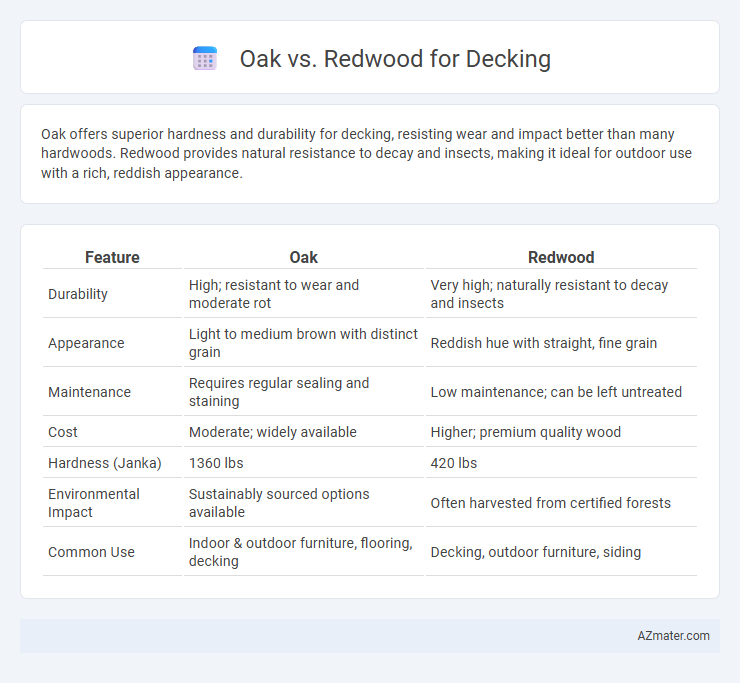Oak offers superior hardness and durability for decking, resisting wear and impact better than many hardwoods. Redwood provides natural resistance to decay and insects, making it ideal for outdoor use with a rich, reddish appearance.
Table of Comparison
| Feature | Oak | Redwood |
|---|---|---|
| Durability | High; resistant to wear and moderate rot | Very high; naturally resistant to decay and insects |
| Appearance | Light to medium brown with distinct grain | Reddish hue with straight, fine grain |
| Maintenance | Requires regular sealing and staining | Low maintenance; can be left untreated |
| Cost | Moderate; widely available | Higher; premium quality wood |
| Hardness (Janka) | 1360 lbs | 420 lbs |
| Environmental Impact | Sustainably sourced options available | Often harvested from certified forests |
| Common Use | Indoor & outdoor furniture, flooring, decking | Decking, outdoor furniture, siding |
Introduction to Oak and Redwood Decking
Oak decking offers exceptional hardness and durability, making it a popular choice for high-traffic outdoor spaces due to its dense grain and resistance to wear. Redwood decking is prized for its natural resistance to decay and insects, with a rich reddish hue that enhances outdoor aesthetics while requiring minimal maintenance. Both wood types provide robust structural integrity, but oak's strength suits heavy use, whereas redwood's naturally weather-resistant oils ensure long-lasting beauty in various climates.
Wood Characteristics: Oak vs Redwood
Oak features a dense, hard grain structure that provides excellent durability and resistance to wear, making it ideal for high-traffic decking areas, while its natural light to medium brown tones offer a classic, versatile finish. Redwood is prized for its straight grain and rich reddish hues, combined with natural oils that enhance its resistance to decay, insects, and moisture, providing superior longevity in outdoor settings. Both woods offer unique textures and structural strengths, but oak's hardness contrasts with redwood's lighter weight and inherent weather resistance, influencing choice based on specific decking needs.
Durability and Lifespan Comparison
Oak and redwood both offer strong durability for decking, but redwood excels with natural resistance to decay, insects, and moisture, extending its lifespan significantly. Oak, especially white oak, is durable and dense but requires proper sealing and maintenance to prevent rot and insect damage over time. Redwood decking typically lasts 20-30 years with minimal upkeep, whereas oak decks may need more frequent care but can last up to 25 years under optimal conditions.
Aesthetic Appeal and Color Differences
Oak decking offers a classic, warm appearance with its light to medium brown hues and prominent grain patterns, creating a timeless and elegant outdoor space. Redwood features rich reddish tones and a fine, straight grain that adds a natural, vibrant aesthetic with deep color variations ranging from light pink to dark crimson. Both woods age beautifully, but oak tends to develop a silver-gray patina over time, while redwood maintains more of its warm red coloration with proper sealing.
Resistance to Weather and Insects
Redwood offers superior natural resistance to weather and insects due to its high tannin content, making it a durable choice for outdoor decking in humid or rainy climates. Oak, while strong and dense, is more susceptible to moisture absorption and insect damage unless properly treated with sealants or preservatives. Choosing redwood reduces long-term maintenance costs and enhances structural integrity in environments prone to fungal decay and termite infestations.
Maintenance Requirements for Each Wood
Oak decking demands regular sealing and staining to prevent moisture penetration and maintain its durability, as it is prone to warping and rot if left untreated. Redwood naturally contains tannins and oils that resist decay and insect damage, reducing the frequency of maintenance compared to oak. While both woods benefit from periodic cleaning, redwood's inherent resistance allows for less intensive upkeep, making it a preferred choice for low-maintenance decks.
Environmental Sustainability and Sourcing
Redwood decking is highly valued for its natural resistance to decay and insects, often harvested from sustainably managed forests with certifications like FSC, ensuring responsible sourcing practices. Oak, while durable and strong, typically requires more intensive chemical treatments to enhance longevity, potentially impacting environmental sustainability negatively. Choosing redwood from well-managed sources minimizes ecological footprint compared to oak, which often relies on slower replenishing or less regulated harvesting methods.
Cost and Availability Differences
Oak decking typically costs less than redwood due to its widespread availability and faster growth rate, making it a budget-friendly option for many homeowners. Redwood, prized for its natural resistance to decay and insect damage, commands higher prices and is less readily available, especially in regions far from the West Coast where it is harvested. The choice between oak and redwood decking often hinges on balancing upfront cost constraints against long-term durability and maintenance needs.
Installation Considerations
Oak decking requires careful sealing and regular maintenance to prevent moisture absorption and warping during installation, given its dense grain and hardness. Redwood offers easier installation due to its lightweight structure and natural resistance to rot and insects, reducing the need for chemical treatments and frequent repairs. Proper fasteners and pre-drilling are essential for both woods to avoid splitting and ensure long-term stability of the deck.
Final Verdict: Choosing Between Oak and Redwood
Oak offers exceptional hardness and durability, making it ideal for high-traffic decking areas resistant to dents and wear. Redwood provides natural resistance to decay and insects, with a rich color that requires less maintenance over time. Selecting between oak and redwood depends on priorities: oak suits strength and longevity, while redwood excels in weather resistance and aesthetic appeal.

Infographic: Oak vs Redwood for Decking
 azmater.com
azmater.com